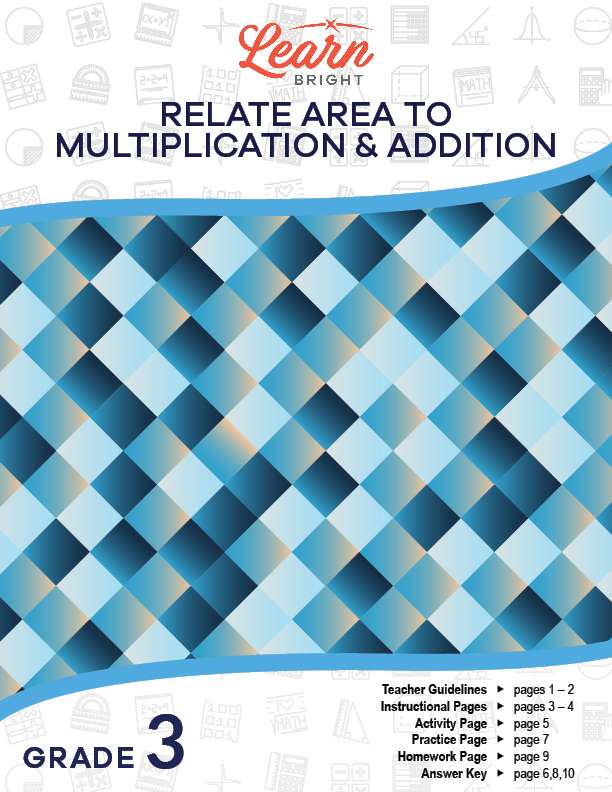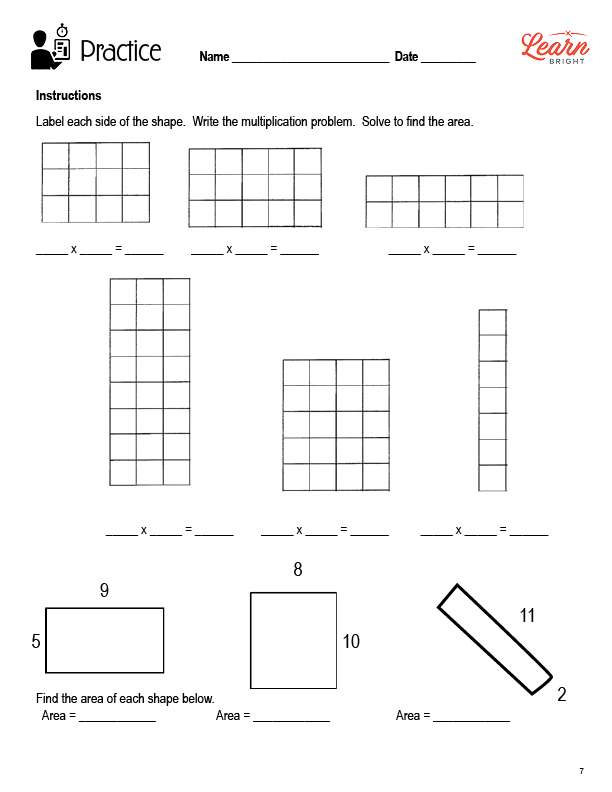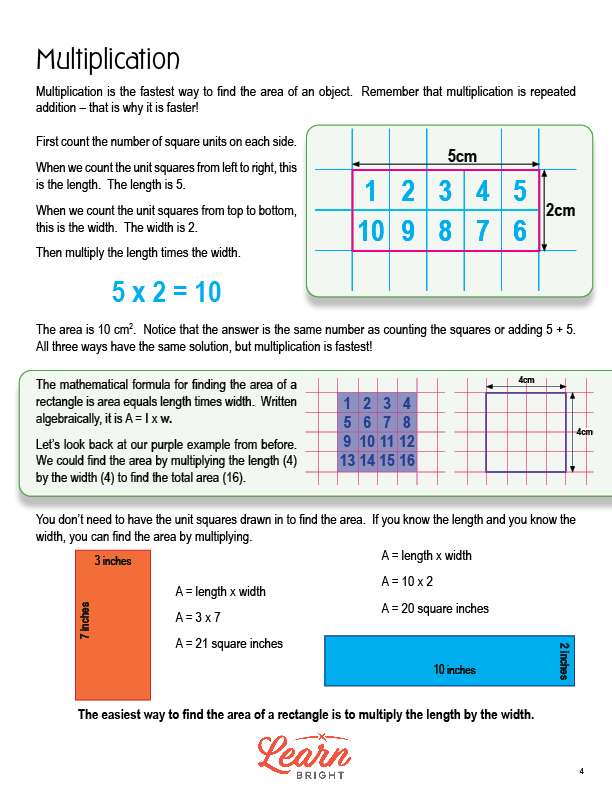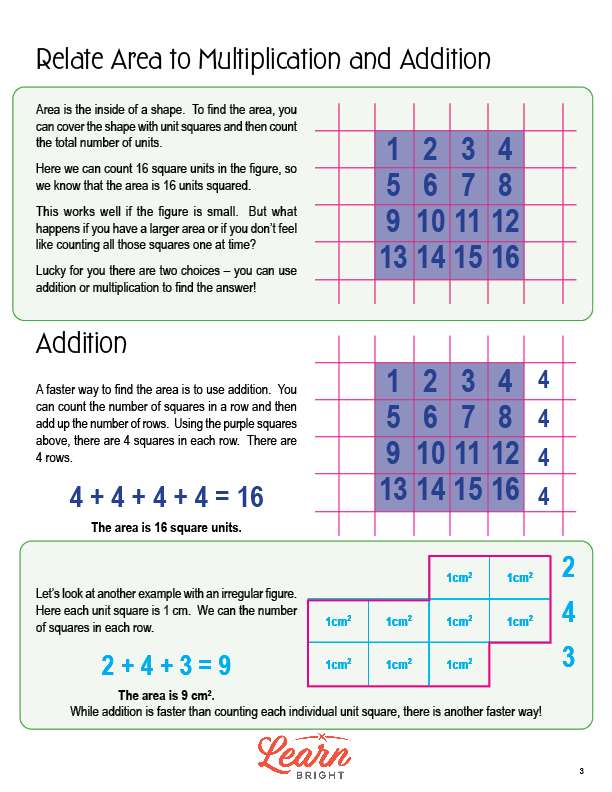Description
What our Relate Area to Multiplication and Addition lesson plan includes
Relate Area to Multiplication and Addition teaches students how we use addition and multiplication in relation to finding the area of a shape. At the end of the lesson, students will be able to relate area to the operations addition and multiplication. This lesson is for students in 3rd grade.
Classroom Procedure
Every lesson plan provides you with a classroom procedure page that outlines a step-by-step guide to follow. You do not have to follow the guide exactly. The guide helps you organize the lesson and details when to hand out worksheets. It also lists information in the blue box that you might find useful. You will find the lesson objectives, state standards, and number of class sessions the lesson should take to complete in this area. In addition, it describes the supplies you will need as well as what and how you need to prepare beforehand. The supplies you will need for this lesson are grid paper, colored pencils or markers, and the handouts. To prepare for this lesson ahead of time, you can copy the handouts and gather the supplies.
Options for Lesson
Included with this lesson is an “Options for Lesson” section that lists a number of suggestions for activities to add to the lesson or substitutions for the ones already in the lesson. For this lesson, one optional adjustment is to do the activity worksheet as a whole class. If you choose to do that, you should demonstrate how to add and multiply to find the area for the class. Students can also use grid paper to cut out their own rectangles to demonstrate total area. For example, they could create a rectangle with a total area of 24 that could be created in different ways (6 x 4, 3 x 8, 2 x 12, etc.).
Teacher Notes
The teacher notes page includes a paragraph with additional guidelines and things to think about as you begin to plan your lesson. This page also includes lines that you can use to add your own notes as you’re preparing for this lesson.
RELATE AREA TO MULTIPLICATION AND ADDITION LESSON PLAN CONTENT PAGES
Relate Area to Multiplication and Addition
The Relate Area to Multiplication lesson plan includes two content pages. This lesson begins with a quick overview of area. Area is the inside of a shape. In order to find the area of a shape, you can cover it with unit squares and count the total number of units. The lesson includes an example with 16 units. This means that the area is 16 square units (or units squared). This method works well for small shapes. However, if you have a larger shape, you should not count all of those squares individually! Instead, you can use either addition or multiplication to find the total area.
Addition
One faster way to find area is using addition. To use this method, you can count the number of squares in one row and then add up the total number of rows. In the example shown, there are four squares in each row and four rows, so you would add 4 + 4 + 4 + 4 = 16. The lesson also includes a second addition example with an irregular figure. However, it also notes that, while addition is a faster method than individually counting units, there’s an even faster method—multiplication!
Multiplication
Multiplication is the fastest way to find area. It’s faster than addition, because multiplication is simply repeated addition! To use this method, you must count the total number of unit squares on each side of the figure and then multiply them together. In the example shown in the lesson, the length is 5 and the width is 2. Therefore, to find the area of that figure, you would multiply 5 x 2 = 10. You would get the same answer if you used addition, but this way is faster.
The algebraic formula for finding the area of a rectangle is A = l x w (Area = length x width). To solve the previous example, shown in the addition section of the lesson, using this formula, you would simply multiply 4 x 4 to get 16.
You don’t need to draw the unit squares to find the area using multiplication. You simply need the length and width. The lesson closes with a few more helpful examples.
RELATE AREA TO MULTIPLICATION AND ADDITION LESSON PLAN WORKSHEETS
The Relate Area to Multiplication lesson plan includes three worksheets: an activity worksheet, a practice worksheet, and a homework assignment. You can refer to the guide on the classroom procedure page to determine when to hand out each worksheet.
DRAWING SHAPES ACTIVITY WORKSHEET
For the activity worksheet, students will follow the instructions to draw various shapes in different sizes on grid paper. For example, they will draw a rectangle on the paper that has an area equal to one square unit. They will then have to determine how many total squares they colored for each shape they draw. Finally, they will explain how they could have found the area without drawing in all of the units, with an example.
LABELLING SHAPES PRACTICE WORKSHEET
The practice worksheet asks students to label each side of the provided shapes, write a multiplication problem for each, and then solve to find the area. They will also find the area of three shapes whose sides are labelled with measurements.
RELATE AREA TO MULTIPLICATION AND ADDITION HOMEWORK ASSIGNMENT
For the homework assignment, students will find the area for nine shapes using the provided measurements.
Worksheet Answer Keys
This lesson plan includes answer keys for the activity worksheet, the practice worksheet, and the homework assignment. If you choose to administer the lesson pages to your students via PDF, you will need to save a new file that omits these pages. Otherwise, you can simply print out the applicable pages and keep these as reference for yourself when grading assignments.









